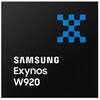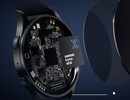Samsung Exynos W920 vs Samsung Exynos W930 vs Samsung Exynos W1000
Samsung Exynos W920
► remove from comparison
The Samsung Exynos W920 is a dual-core ARM based SoC for IoT (Internet of Things) devices like smartwatches. It was announced in 2021 and integrates two ARM Cortex A55 cores clocked at 1.18 GHz. It is manufactured in the modern 5nm process. In addition to the CPU cores, the chip also integrates a ARM Mali-G68 MP2 GPU, Cat.4 (DL) / Cat.5 (UL) LTE modem, 1080p HEVC/H.264/VP8 video engine and a LPDDR4 memory controller.
Samsung Exynos W930
► remove from comparison
The Samsung Exynos W930 is a SoC intended for smartwatches that was announced in mid 2023. It integrates two small ARM Cortex-A55 CPU cores at up to 1.4 GHz and an ARM Mali-G68MP2 GPU. The integrated LTE modem supports Cat.4 Download (150 Mbps) and Cat.5 Upload (75 Mbps). For satellite positioning, the SoC supports GPS, GLONASS, Beidou and Galileo. Furthermore, the package integrates 2GB LPDDR4 RAM and 16 GB eMMC.
The chip is manufactured in the relatively modern 5nm process at Samsung.
Samsung Exynos W1000
► remove from comparison
The Samsung Exynos W1000 is a comparatively fast processor (SoC) for use in smart wearables that was unveiled in July 2024. It features 5 CPU cores (1 Cortex-A78 performance core and 4 Cortex-A55 efficient cores running at ~1.6 GHz and ~1.5 GHz respectively) along with a 4G LTE modem, satellite navigation module, and the Mali-G68 MP2 iGPU. Bluetooth 5.3, Wi-Fi 4 and NFC are all supported as well.
Performance
Octane and Speedometer put it in the same ballpark as the Snapdragon 680 4G. It must be said that the Exynos W930 and W920 both had just 2 CPU cores, meaning the jump in performance that the newer chip brings to the table is quite frankly staggering.
Graphics
We expect the Mali-G68 MP2 to be exactly as fast as the G57 MP2 (assuming the G68 MP2 is half as fast as the G68 MP4, which it should be). As a GPU unveiled in 2020, this humble Mali series member does not have hardware ray tracing or any other modern skills.
While the W930 and the W920 came equipped with the very same GPU, it probably runs at somewhat higher clock speeds in the W1000.
Power consumption
As an SoC for smartwatches, the Exynos is unlikely to ever consume more than 2 W or 3 W (even briefly) because that would obliterate the device's battery life.
The Exynos series SoC is built with a 3 nm process for good, as of late 2024, power efficiency.
| Model | Samsung Exynos W920 | Samsung Exynos W930 | Samsung Exynos W1000 |
| Codename | ARM Cortex-A55 | ARM Cortex-A55 | |
| Clock | 1180 MHz | 1400 MHz | 1500 MHz |
| Cores / Threads | 2 / 2 | 2 / 2 | 5 / 5 1 x ARM Cortex-A78 4 x ARM Cortex-A55 |
| Technology | 5 nm | 5 nm | 3 nm |
| Features | Mali-G68MP2, qHD 960x540 Display Support, LTE Cat.4 150Mbps DL / Cat.5 75Mbps UL, GNSS (GPS, GLONASS, Beidou, Galileo), LPDDR4 (12Gb), FHD 30fps video | 2x 1.4 GHz ARM Cortex-A55, ARM Mali-G68MP2, qHD (960x540) Display Support, LTE Cat.4 150MBps (DL), Cat.5 75Mbps (UL), GPS, GLONASS, Beidou, Galileo, eMMC 16GB | |
| iGPU | ARM Mali-G68 MP2 | ARM Mali-G68 MP2 | ARM Mali-G68 MP2 |
| Architecture | ARM | ARM | |
| Announced | |||
| Manufacturer | semiconductor.samsung.com | semiconductor.samsung.com | |
| TDP Turbo PL2 | 3 Watt |
Benchmarks
Average Benchmarks Samsung Exynos W920 → 100% n=3
Average Benchmarks Samsung Exynos W930 → 149% n=3
Average Benchmarks Samsung Exynos W1000 → 628% n=3
* Smaller numbers mean a higher performance
1 This benchmark is not used for the average calculation











